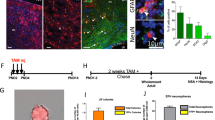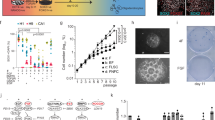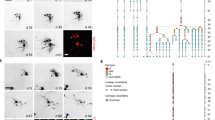Abstract
Adult neurogenesis is a lifelong feature of brain plasticity; however, the potency of adult neural stem/progenitor cells in vivo remains unclear. We found that retrovirus-mediated overexpression of a single gene, the bHLH transcription factor Ascl1, redirected the fate of the proliferating adult hippocampal stem/progenitor (AHP) progeny and lead to the exclusive generation of cells of the oligodendrocytic lineage at the expense of newborn neurons, demonstrating that AHPs in the adult mouse brain are not irrevocably specified in vivo. These data indicate that AHPs have substantial plasticity, which might have important implications for the potential use of endogenous AHPs in neurological disease.
This is a preview of subscription content, access via your institution
Access options
Subscribe to this journal
Receive 12 print issues and online access
$209.00 per year
only $17.42 per issue
Buy this article
- Purchase on Springer Link
- Instant access to full article PDF
Prices may be subject to local taxes which are calculated during checkout







Similar content being viewed by others
References
Gage, F. Mammalian neural stem cells. Science 287, 1433–1438 (2000).
Alvarez-Buylla, A. & Lim, D.A. For the long run: maintaining germinal niches in the adult brain. Neuron 41, 683–686 (2004).
van Praag, H. et al. Functional neurogenesis in the adult hippocampus. Nature 415, 1030–1034 (2002).
Ge, S., Yang, C.H., Hsu, K.S., Ming, G.L. & Song, H. A critical period for enhanced synaptic plasticity in newly generated neurons of the adult brain. Neuron 54, 559–566 (2007).
Carleton, A., Petreanu, L.T., Lansford, R., Alvarez-Buylla, A. & Lledo, P.M. Becoming a new neuron in the adult olfactory bulb. Nat. Neurosci. 6, 507–518 (2003).
Sahay, A. & Hen, R. Adult hippocampal neurogenesis in depression. Nat. Neurosci. 10, 1110–1115 (2007).
Zhao, C., Deng, W. & Gage, F.H. Mechanisms and functional implications of adult neurogenesis. Cell 132, 645–660 (2008).
Noctor, S.C., Flint, A.C., Weissman, T.A., Dammerman, R.S. & Kriegstein, A.R. Neurons derived from radial glial cells establish radial units in neocortex. Nature 409, 714–720 (2001).
Ahn, S. & Joyner, A.L. In vivo analysis of quiescent adult neural stem cells responding to Sonic hedgehog. Nature 437, 894–897 (2005).
Doetsch, F., Caille, I., Lim, D.A., Garcia-Verdugo, J.M. & Alvarez-Buylla, A. Subventricular zone astrocytes are neural stem cells in the adult mammalian brain. Cell 97, 703–716 (1999).
Consiglio, A. et al. Robust in vivo gene transfer into adult mammalian neural stem cells by lentiviral vectors. Proc. Natl. Acad. Sci. USA 101, 14835–14840 (2004).
Suh, H. et al. In vivo fate analysis reveals the multipotent and self-renewal capacities of Sox2(+) neural stem cells in the adult Hippocampus. Cell Stem Cell 1, 515–528 (2007).
Hack, M.A. et al. Neuronal fate determinants of adult olfactory bulb neurogenesis. Nat. Neurosci. 8, 865–872 (2005).
Jackson, E.L. et al. PDGFRα-positive B cells are neural stem cells in the adult SVZ that form glioma-like growths in response to increased PDGF signaling. Neuron 51, 187–199 (2006).
Gabay, L., Lowell, S., Rubin, L.L. & Anderson, D.J. Deregulation of dorsoventral patterning by FGF confers trilineage differentiation capacity on CNS stem cells in vitro. Neuron 40, 485–499 (2003).
Ray, J. & Gage, F.H. Differential properties of adult rat and mouse brain-derived neural stem/progenitor cells. Mol. Cell. Neurosci. 31, 560–573 (2006).
Seaberg, R.M. & van der Kooy, D. Adult rodent neurogenic regions: the ventricular subependyma contains neural stem cells, but the dentate gyrus contains restricted progenitors. J. Neurosci. 22, 1784–1793 (2002).
Bull, N.D. & Bartlett, P.F. The adult mouse hippocampal progenitor is neurogenic, but not a stem cell. J. Neurosci. 25, 10815–10821 (2005).
Rowitch, D.H. Glial specification in the vertebrate neural tube. Nat. Rev. Neurosci. 5, 409–419 (2004).
Parras, C.M. et al. Mash1 specifies neurons and oligodendrocytes in the postnatal brain. EMBO J. 23, 4495–4505 (2004).
Battiste, J. et al. Ascl1 defines sequentially generated lineage-restricted neuronal and oligodendrocyte precursor cells in the spinal cord. Development 134, 285–293 (2007).
Petryniak, M.A., Potter, G.B., Rowitch, D.H. & Rubenstein, J.L. Dlx1 and Dlx2 control neuronal versus oligodendroglial cell fate acquisition in the developing forebrain. Neuron 55, 417–433 (2007).
Duan, X. et al. Disrupted-In-Schizophrenia 1 regulates integration of newly generated neurons in the adult brain. Cell 130, 1146–1158 (2007).
Sherman, D.L. & Brophy, P.J. Mechanisms of axon ensheathment and myelin growth. Nat. Rev. Neurosci. 6, 683–690 (2005).
Avilion, A.A. et al. Multipotent cell lineages in early mouse development depend on SOX2 function. Genes Dev. 17, 126–140 (2003).
Couillard-Despres, S. et al. Doublecortin expression levels in adult brain reflect neurogenesis. Eur. J. Neurosci. 21, 1–14 (2005).
Lu, Q.R. et al. Common developmental requirement for Olig function indicates a motor neuron/oligodendrocyte connection. Cell 109, 75–86 (2002).
Poitras, L., Ghanem, N., Hatch, G. & Ekker, M. The proneural determinant MASH1 regulates forebrain Dlx1/2 expression through the I12b intergenic enhancer. Development 134, 1755–1765 (2007).
Kim, E.J., Leung, C.T., Reed, R.R. & Johnson, J.E. In vivo analysis of Ascl1 defined progenitors reveals distinct developmental dynamics during adult neurogenesis and gliogenesis. J. Neurosci. 27, 12764–12774 (2007).
Galichet, C., Guillemot, F. & Parras, C.M. Neurogenin 2 has an essential role in development of the dentate gyrus. Development 135, 2031–2041 (2008).
Liu, M. et al. Loss of β2/NeuroD leads to malformation of the dentate gyrus and epilepsy. Proc. Natl. Acad. Sci. USA 97, 865–870 (2000).
Miyata, T., Maeda, T. & Lee, J.E. NeuroD is required for differentiation of the granule cells in the cerebellum and hippocampus. Genes Dev. 13, 1647–1652 (1999).
Kondo, T. & Raff, M. Basic helix-loop-helix proteins and the timing of oligodendrocyte differentiation. Development 127, 2989–2998 (2000).
Sugimori, M. et al. Ascl1 is required for oligodendrocyte development in the spinal cord. Development 135, 1271–1281 (2008).
Sugimori, M. et al. Combinatorial actions of patterning and HLH transcription factors in the spatiotemporal control of neurogenesis and gliogenesis in the developing spinal cord. Development 134, 1617–1629 (2007).
Parras, C.M. et al. The proneural gene Mash1 specifies an early population of telencephalic oligodendrocytes. J. Neurosci. 27, 4233–4242 (2007).
Babu, H., Cheung, G., Kettenmann, H., Palmer, T.D. & Kempermann, G. Enriched monolayer precursor cell cultures from micro-dissected adult mouse dentate gyrus yield functional granule cell-like neurons. PLoS ONE 2, e388 (2007).
Palmer, T.D., Ray, J. & Gage, F.H. FGF-2–responsive neuronal progenitors reside in proliferative and quiescent regions of the adult rodent brain. Mol. Cell. Neurosci. 6, 474–486 (1995).
Merkle, F.T., Mirzadeh, Z. & Alvarez-Buylla, A. Mosaic organization of neural stem cells in the adult brain. Science 317, 381–384 (2007).
Pitt, D., Werner, P. & Raine, C.S. Glutamate excitotoxicity in a model of multiple sclerosis. Nat. Med. 6, 67–70 (2000).
Sperk, G. et al. Kainic acid–induced seizures: neurochemical and histopathological changes. Neuroscience 10, 1301–1315 (1983).
Back, S.A. et al. Selective vulnerability of late oligodendrocyte progenitors to hypoxia-ischemia. J. Neurosci. 22, 455–463 (2002).
Zhao, C., Teng, E.M., Summers, R.G. Jr, Ming, G.L. & Gage, F.H. Distinct morphological stages of dentate granule neuron maturation in the adult mouse hippocampus. J. Neurosci. 26, 3–11 (2006).
Lie, D.C. et al. Wnt signaling regulates adult hippocampal neurogenesis. Nature 437, 1370–1375 (2005).
Lein, E.S., Zhao, X. & Gage, F.H. Defining a molecular atlas of the hippocampus using DNA microarrays and high-throughput in situ hybridization. J. Neurosci. 24, 3879–3889 (2004).
Hsieh, J. et al. IGF-I instructs multipotent adult neural progenitor cells to become oligodendrocytes. J. Cell Biol. 164, 111–122 (2004).
Acknowledgements
We thank M.L. Gage for editing the manuscript. The study was supported by grants from the Deutsche Forschungsgemeinschaft (Je297/1-1), American Epilepsy Society, Swiss National Science Foundation (to S.J.), and the US National Institute on Aging, the US National Institute of Neurological Disorders and Stroke, the Lookout Fund, the Christopher and Dana Reeve Foundation, the Picower Foundation and Project ALS (to F.H.G.).
Author information
Authors and Affiliations
Contributions
S.J. conceived and carried out the experiments, analyzed the data and wrote the manuscript. N.T. performed the electron microscopy experiment. G.D.C. participated in viral injections and histological procedures. J.R. provided the stem cell cultures. F.H.G. revised the manuscript, gave conceptual input and obtained financial support.
Corresponding authors
Supplementary information
Supplementary Text and Figures
Supplementary Figures 1–4 (PDF 2235 kb)
Rights and permissions
About this article
Cite this article
Jessberger, S., Toni, N., Clemenson Jr, G. et al. Directed differentiation of hippocampal stem/progenitor cells in the adult brain. Nat Neurosci 11, 888–893 (2008). https://doi.org/10.1038/nn.2148
Received:
Accepted:
Published:
Issue Date:
DOI: https://doi.org/10.1038/nn.2148
This article is cited by
-
Formation and integration of new neurons in the adult hippocampus
Nature Reviews Neuroscience (2021)
-
DCX+ neuronal progenitors contribute to new oligodendrocytes during remyelination in the hippocampus
Scientific Reports (2020)
-
Brain angiotensin type-1 and type-2 receptors: cellular locations under normal and hypertensive conditions
Hypertension Research (2020)
-
Quantitative characterization of proliferative cells subpopulations in the hilus of the hippocampus of adult Wistar rats: an integrative study
Journal of Molecular Histology (2020)
-
The role of adult hippocampal neurogenesis in brain health and disease
Molecular Psychiatry (2019)



